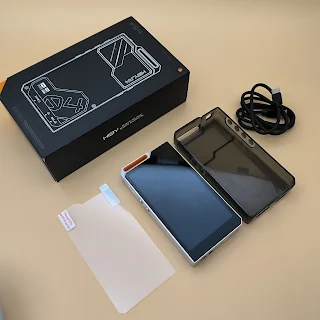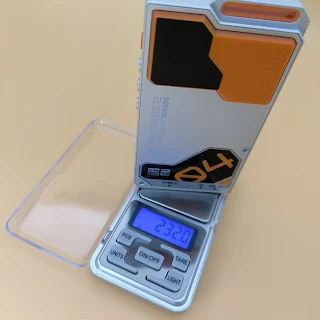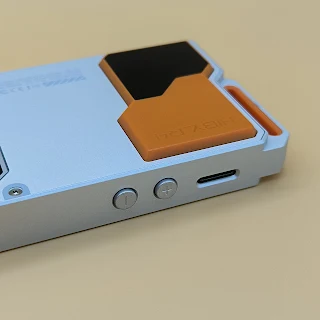Disclaimer: Please note that I am not an audiophile, and this review does not delve into the technical aspects of the IEMs. My impressions are based on my personal preferences, and others may have different experiences with this product. I also have a very limited experience with audio products so please take this review with a grain of salt.
The Hiby R4 was lent to me as part of a review tour in the Philippines.
Introduction
Before I review the Hiby R4, I need to explain what DAPs are. Digital Audio Players (DAPs) are portable devices designed to play high-quality music. Unlike the old-school MP3 players of yesteryear, DAPs focus on delivering superior audio quality. They achieve this by supporting a wide range of audio file formats (such as FLAC, WAV, DSD, and MQA) and incorporating high-end components like Digital-to-Analog Converters (DACs) and amplifiers.
Most DAPs look and feel like phones. Most even run a custom OS with an Android core, but make no mistake, this is NOT a phone, and therefore needs to be treated as such. Don’t expect to surf the internet with DAPs as most don’t have SIM cards. Again, DAPs are NOT phones.
I also have not reviewed any other DAPs so I don’t exactly have a benchmark for any comparison except my Xiaomi Pad 5 tablet with the Hidizs S9 Pro Plus Martha dongle DAC.
Pros
- Solid build quality
- Interesting design choice
- Powerful output
- Multiple output options: 3.5mm, 4.4mm, USB-C, Bluetooth 5.0, can even be used as a PC DAC!
- Multiple options to enhance and customize sound output via equalization or MESB
Cons
- The shape is not very ergonomic, edges are sharp, can be very fatiguing to hold in your hand because of its thickness
- Screen isn’t very bright.
Part 1: General Product Details
Package Inclusions
- The Hiby R4 DAP
- A TPU case
- Extra screen protector film
- USB C to C cable
- Documentation (Warranty cards and manual)
- OS: HibyOS (Android 12)
- SOC: Snapdragon 665
- DAC Chip: ES9018C2M
- 3 GB RAM
- 32 GB internal memory (expandable with a micro SD card up to 2TB)
- 4500 mAh battery (20W charging)
- 4.7” 1080x720 IPS screen
- Weight: ~232g (w/o case), ~264g (w/ case)
Notable Features
- Working Modes - Switch modes for different ways you want to listen to music
- Android Mode - The default mode of the R4, lets you do everything you need to do with an Android phone.
- Pure Audio Mode - Minimizes the Android resources used and runs just the Hiby Music player. Potentially can save battery life.
- USB DAC Mode - When you want to use the R4 as a DAC for your PC, or your phone. I mean it’s possible, I’m not going to stop you.
- Bluetooth Receiving Mode - Takes advantage of the Bluetooth 5.0 capability and will allow you to use wireless headsets.
- MSEB - short for MageSound Eight-Ball is a Hiby-exclusive functionality that lets users alter the sound output besides the regular 10-band equalizer. In MSEB there are a few parameters that you can alter in a scale, like the overall sound temperature, bass extension & texture, note thickness, and more. You can actually try this out on the HibyMusic app.
Part 2: Subjective review
General Usage Impressions
- The review unit already had quite a few scratches when it arrived. Not really a big deal, as I’m sure it won’t affect the sound output. I did eventually decide to replace the screen protector for the next reviewer, but that was after I had already taken photos.
- The R4 feels very solid and weighty. The frame is made of metal, with some parts made of plastic. I’m not a fan of its angular design, especially the edges. They are definitely sharp, don’t expect to use this without the protective case.
- Setting up the device was painless, boot it up, setup the theme, the language, connect to a wifi, and you’re done. I did run into a minor hiccup where Settings stopped responding (see screenshot).
- 11GB out of the 32 GB is already occupied by system files, leaving me with ~20GB. Fortunately I had a microSD lying around so I filled that up with my FLAC files.
- It was a little disorienting to traverse the OS since you don’t have the usual 3-button navigation at the bottom. Android 12 though has gestures so you can use that to go where you need to be.
- By default Hiby Music was already installed, which is one of my offline players of choice. Hiby Music also has a Tidal integration, but I much prefer using the standalone Tidal app. Since the Tidal app isn’t available in the Philippines, I sideloaded the APK which was not a problem.
- If you rather listen to Spotify, Youtube Music, Apple Music, or any other streaming services, you can download those on the Google Playstore. Don’t forget to save your music on the device when you’re going out though!
- Don’t expect to use the R4 for movies, the screen resolution is small and not bright enough for me. Just use your phone.
Sound Impressions
- Without fiddling with any settings, the R4 blew me away with how much power it gave the Moondrop May even at a low volume the difference in sound as compared to using a dongle with my phone was apparent.
- Using the R4 as a desktop DAC was a surprise, I didn’t know DAPs could do this. It was able to go head to head with my current iFi Nano iDSD LE.
- The R4 has a neutral sound, nothing really stands out to me as off.
Nitpicks
- The ⏮️ Previous / ▶️ Play / ⏭️ Next buttons only make sense if the R4 is faced down. When I had the R4 in my pocket, I instinctively pressed the top button for Next and was surprised when it went to the previous instead.
- The Power, Previous, Play, and Next side buttons also don’t feel consistent. The Previous button feel like it’s almost stuck. The Volume Up and Down feel very tactile
- The screen / screen protector is a fingerprint magnet. I wish the screen had a more rectangular shape so I can get a generic screen protector and easily cut it to size. I also wish they added wet and dry wipes for when you need to replace the screen protector - which I did. I also wish they had tempered glass instead of film screen protectors, as the ones that come with the R4 are total fingerprint and scratch magnets.
- The rear RGB lights are basically covered by the case. A light colored case would have been better to showCASE (eeeey) the colors of the back and the lights
Final Thoughts
The Hiby R4 is an interesting piece of tech to me. Being able to have mulitple output options as well as working modes, the R4 can truly be called an all-in-one audio device. As a guy who works 90% on my computer, being able to use it as a DAC was a treat and my favorite use of the R4.
For a casual like me, the price is a little steep but if I could afford it, the R4 would be the DAP I’d love to have in my possession for its sheer versatility and value without compromising on audio quality and battery life.
More Photos
___________________________________________________________________________________
6-Hour Battery Tests
Overnight Idle (Connected to Wifi)
- Start: 99% at 11:20pm
- End: 97% at 8:51am
Charging (R4 is off)
- 65W GAN charging brick
- Start: 27% at 3:50pm
- Check 1: 55% at 4:13 pm (+28% after 23m)
- Check 2: 70% at 4:30 pm (+15% after 17m / 40m total)
- Check 3: 91% at 4:56 pm (+21% after 26m / 1h6m total)
- Full: 5:20 pm (+9% after 24m / 1h30m total)
- Charging time from 27% to 100%: 1h30m
- Note: When the battery got to 91% I was watching and waiting like a hawk, that last 10% took way longer than it should. to charge. 😂
Streaming music via Tidal app
Hiby R4: Low Gain / Volume: 30 / 3.5mm out / Screen Off / Android Mode / Moondrop May IEMs
- Start: 96% at 9:31am
- Check 1: 76% at 11:30am (-20% after 2h)
- Check 2: 53% at 1:30pm (-23% after 2h / 4h total)
- Check 3: 29% at 3:30pm (-24% after 2h / 67% after 6h total)
- Notes:
- The R4 got warm to the touch, but not to an uncomfortable level.
- At some point I think I accidentally pressed the volume down button twice and it was at 28 when I checked for the last photo.
Playing FLAC files with HibyMusic app (Android Mode)
Files are loaded from a microSD
Hiby R4: Low Gain / Volume: 30 / 3.5mm out / Screen Off / Android Mode / Moondrop May IEMs
- Start: 100% at 7:50am
- Check 1: 85% at 9:50am (-15% after 2h)
- Check 2: 67% at 11:50am (-18% after 2h / 4h total)
- Check 3: 45% at 2:06pm (-22% after 2h16m / 55% after 6h16m total)
- Note: Same as the previous test, the R4 got warm, but not as warm as the previous test. It was very much tolerable.
Playing FLAC files with HibyMusic app (Pure Audio Mode)
Files are loaded from a microSD
Hiby R4: Low Gain / Volume: 30 / 3.5mm out / Screen Off / Pure Audio Mode / Moondrop May IEMs
- Start: at 97% at 2:07pm
- Check 1: 82% at 4:07 (-15% after 2h)
- Check 2: 65% at 6:07 (-17% after 2h / 4h total)
- Check 3: 45% at 8:07 (-20% after 2h / 52% after 6 total)
- Notes:
- The heat generated by the R4 during this test was basically the same as when it was on Android mode.
- Looking at the difference in bettery consumption between Android Mode and Full Audio Mode, I think it’s negligible.





.jpg)





.jpg)










